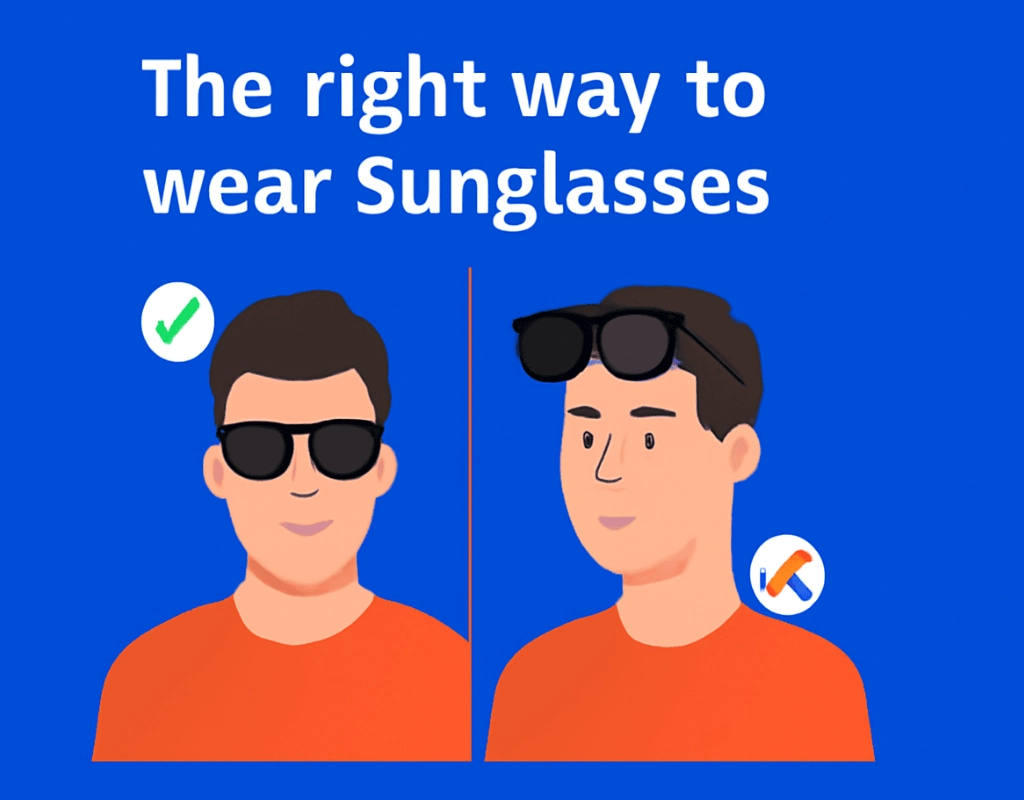Sunglasses aren’t just for summer—they are essential accessories for eye protection and style. Whether you’re wearing them on a beach holiday or as part of your everyday outfit, knowing how to wear sunglasses correctly is more than just about looking cool. In this article, we explore proper sunglasses etiquette, discuss how to choose the right pair for various occasions, and cover some common mistakes to avoid. By the end of this article, you’ll understand how to select the perfect sunglasses that complement both your face shape and your lifestyle.

1. How Can You Properly Wear Sunglasses?
When you think of sunglasses, what comes to mind? Fashion, function, or perhaps both? But here’s the kicker: sunglasses aren’t just an accessory—they are crucial for eye health. Wearing sunglasses isn’t just about preventing squinting in the sun; it’s about protecting your eyes from harmful UV rays. UV rays can cause long-term damage, including cataracts and macular degeneration. So how do you ensure you’re wearing them properly?
First, always wear sunglasses outdoors, especially during the midday hours when the sun is strongest. Ready for the good part? Not all sunglasses are created equal. The most important feature to look for is UV protection. Opt for sunglasses that block 100% of UVA and UVB rays. You also need to make sure they fit your face. Sunglasses should rest comfortably on your nose without sliding down or pinching. This is where it gets interesting: ensuring proper fit is key to both comfort and function. Sunglasses that are too tight or too loose can cause discomfort or fail to protect your eyes effectively.
Table 1: UV Protection Ratings
| UV Protection | Rating | Benefit |
|---|---|---|
| 100% UVA/UVB | UV400 | Blocks 100% of UV rays |
| 80% UVA/UVB | UV380 | Blocks most UV rays |
| 50% UVA/UVB | UV360 | Blocks a significant portion of UV rays |
2. What Are the Common Mistakes to Avoid When Wearing Sunglasses?
Sunglasses are more than just a fashion statement—they serve a vital function in protecting your eyes. What’s the real story? Wearing sunglasses incorrectly can lead to unnecessary eye strain, and even worse, it can expose your eyes to harmful rays. Here are some common mistakes to avoid:
- Wearing sunglasses indoors: Some people wear sunglasses indoors, which can cause discomfort. Here’s the deal: sunglasses are meant for sunlight, and wearing them indoors can disrupt your vision and make things unnecessarily dark.
- Choosing sunglasses with no UV protection: Sunglasses without proper UV protection can do more harm than good. Ready for the good part? They may actually cause your pupils to dilate, letting in more UV light than if you were wearing no sunglasses at all.
- Wearing oversized sunglasses on windy days: Oversized frames are stylish, but they can be impractical. When wearing them on a windy day, they can fly off easily, causing you to lose your sunglasses. Here’s the kicker: look for sunglasses that fit snugly without being too tight.
Table 2: Common Mistakes with Sunglasses
| Mistake | Solution |
|---|---|
| Wearing sunglasses indoors | Wear sunglasses only outdoors |
| Choosing sunglasses without UV protection | Always check for UV400 protection |
| Wearing oversized sunglasses on windy days | Choose sunglasses that fit properly |
3. How Do You Match Sunglasses with Your Outfit?
Sunglasses are an extension of your personal style. They can either complete your look or stand out as a statement piece. But here’s the kicker: wearing sunglasses that match your outfit can elevate your overall appearance. To get it right, there are a few guidelines to follow:
- Casual Wear: For a laid-back look, choose classic sunglasses styles like aviators or wayfarers. These sunglasses complement nearly every casual outfit, whether it’s a T-shirt and jeans or a summer dress.
- Formal Wear: When dressing up, opt for sunglasses that are more refined. What’s the real story? Go for sleek, thin-framed sunglasses, or if you’re feeling adventurous, try a bold color for a touch of personality without overdoing it.
- Outdoor Activities: If you’re spending time outdoors, look for sunglasses designed for specific activities, like sports sunglasses with a wraparound frame for optimal protection.
Table 3: Sunglasses for Different Outfits
| Occasion | Ideal Sunglasses | Frame Style |
|---|---|---|
| Casual Wear | Aviators, Wayfarers | Classic, Simple |
| Formal Wear | Thin-framed, Square frames | Sleek, Elegant |
| Outdoor Sports | Wraparound, Sports glasses | Active, Secure Fit |
4. How Can You Maintain Your Sunglasses?
To ensure your sunglasses last for years, proper care and maintenance are essential. What’s the real story? Neglecting your sunglasses can lead to scratches, broken frames, and lens discoloration. Here’s how to keep them in pristine condition:
- Cleaning: Always clean your lenses with a microfiber cloth. What’s the kicker? Using a paper towel or your shirt may scratch the lenses.
- Storage: When not in use, always store your sunglasses in a case. Ready for the good part? This will protect them from being crushed or scratched.
- Avoiding Direct Heat: Never leave your sunglasses in a hot car or on direct sunlight for too long. Extreme temperatures can warp the frames or cause the lenses to become cloudy.
Table 4: Sunglasses Care Tips
| Care Tip | Benefit |
|---|---|
| Use microfiber cloth for cleaning | Prevents scratches on lenses |
| Store in a hard case | Prevents frame damage or scratches |
| Avoid heat and direct sunlight | Prevents lens discoloration and warping |
5. What Are the Best Sunglasses for Different Face Shapes?
Not all sunglasses will flatter every face shape. Here’s the deal: choosing the right sunglasses for your face shape can enhance your appearance. Here’s a quick guide to matching sunglasses to different face shapes:
- Round Faces: Go for angular frames like square or rectangular glasses. These shapes will add contrast and definition to the softness of your face.
- Square Faces: Oval or round sunglasses will soften sharp angles, adding balance to your facial features.
- Oval Faces: Almost any style works well, but you can experiment with bold frames like cat-eye sunglasses for a fashion-forward look.
Table 5: Sunglasses for Different Face Shapes
| Face Shape | Ideal Frame Style |
|---|---|
| Round | Square, Rectangular frames |
| Square | Oval, Round frames |
| Oval | Almost any style, especially bold frames |
6. What Are the Health Benefits of Wearing Sunglasses?
Wearing sunglasses isn’t just about looking good. This is where it gets interesting: sunglasses provide significant health benefits. Not only do they protect your eyes from UV rays, but they also help reduce eye strain. Here are some key benefits:
- UV Protection: Sunglasses block harmful UV rays that can lead to cataracts and other eye diseases.
- Reduced Eye Strain: Bright sunlight can cause discomfort and headaches. Sunglasses reduce this strain by filtering out excess light.
- Protection Against Dry Eyes: Wind and dust can dry out your eyes. Sunglasses can act as a barrier against these elements, especially in outdoor settings.
Table 6: Health Benefits of Sunglasses
| Benefit | Description |
|---|---|
| UV Protection | Prevents long-term damage to eyes |
| Reduced Eye Strain | Alleviates discomfort and headaches |
| Protection Against Dry Eyes | Shields against wind and dust |
7. How Can You Tell If Your Sunglasses Are Providing Adequate UV Protection?
Not all sunglasses are created equal. Here’s the kicker: some sunglasses may look great but lack proper UV protection. Here’s how to ensure your sunglasses provide adequate protection:
- Check the label: Look for a label that indicates 100% UV protection or UV400.
- Test them with a UV light: Some opticians offer UV tests, or you can use an online UV light test to verify.
- Buy from reputable brands: Well-known eyewear brands are more likely to meet UV protection standards.
Table 7: UV Protection Ratings
| UV Protection | Rating | Benefit |
|---|---|---|
| UV400 | 100% | Blocks all UVA and UVB rays |
| UV380 | 80% | Blocks most UV rays |
| UV360 | 50% | Blocks a significant portion of UV rays |
8. How Do Sunglasses Enhance Your Personal Style?
Sunglasses aren’t just functional—they’re also a statement of style. But here’s the kicker: the right sunglasses can elevate your personal brand and influence how others perceive you. Whether you’re going for a bold, attention-grabbing look or a subtle, sophisticated vibe, your choice of sunglasses can define your style. Here are some tips:
- Match your sunglasses with your wardrobe: Consider the colors and styles of your outfits to choose sunglasses that complement your overall look.
- Don’t be afraid to experiment: Sunglasses come in all shapes, sizes, and colors. This is where it gets interesting: bold frames can express confidence, while sleek frames show refinement.
Table 8: Sunglasses Styles for Different Personalities
| Personality | Ideal Frame Style |
|---|---|
| Bold | Bold, oversized frames |
| Refined | Sleek, minimalistic frames |
| Adventurous | Sporty, wraparound sunglasses |
9. What Are the Different Types of Sunglasses Lenses?
When it comes to lenses, there are several options available. What’s the real story? The type of lens you choose depends on your lifestyle and needs. Here are some popular lens options:
- Polarized Lenses: Great for reducing glare, especially when driving or participating in water activities.
- Mirrored Lenses: These lenses reflect light, reducing the amount of light entering your eyes, making them great for bright, sunny days.
- Gradient Lenses: These lenses are darker at the top and gradually get lighter toward the bottom, making them ideal for driving.
Table 9: Types of Sunglasses Lenses
| Lens Type | Benefit |
|---|---|
| Polarized | Reduces glare from surfaces |
| Mirrored | Reflects excess light |
| Gradient | Ideal for driving |
10. How Do You Choose Sunglasses for Different Seasons?
Different seasons require different sunglasses. Here’s the deal: the sunglasses that work well in the summer may not be the best choice for winter or other seasons. Here’s how to select the right pair for any season:
- Summer: Opt for sunglasses that offer full UV protection and are comfortable for long periods outdoors.
- Winter: Snow reflects sunlight, which can cause UV damage, so make sure your sunglasses have proper UV protection.
- Spring/Fall: Choose sunglasses with moderate tint to protect from both the sun and the cooler winds.
Table 10: Sunglasses for Different Seasons
| Season | Ideal Sunglasses |
|---|---|
| Summer | UV-blocking, lightweight |
| Winter | UV-blocking, polarized |
| Spring/Fall | Moderate tint, versatile |
11. Can Sunglasses Be Worn with Prescription Glasses?
Many people require prescription glasses and still want to wear sunglasses. What’s the kicker? There are several ways to make it work:
- Clip-ons: You can buy clip-ons that attach to your regular prescription glasses.
- OTG (Over-the-glasses): These sunglasses are designed to fit over your prescription glasses, providing comfort and protection.
- Prescription Sunglasses: If you prefer a more seamless option, prescription sunglasses provide both vision correction and UV protection.
Table 11: Prescription Eyewear Options
| Option | Description |
|---|---|
| Clip-ons | Attach to regular glasses |
| OTG (Over-the-glasses) | Fits over prescription glasses |
| Prescription Sunglasses | Corrective eyewear with UV protection |
12. How Do You Ensure Sunglasses Fit Comfortably?
Finding sunglasses that fit properly is key. Here’s the deal: sunglasses that are too tight can cause headaches, while loose ones may fall off easily. Follow these tips for a perfect fit:
- Nose Pads: Ensure the nose pads are adjustable and sit comfortably on your nose without sliding down.
- Temple Arms: Make sure the temple arms aren’t too tight around your ears.
- Bridge Fit: The bridge should sit securely but not pinch.
Table 12: Sunglasses Fit Tips
| Tip | Benefit |
|---|---|
| Adjustable Nose Pads | Ensures a comfortable fit |
| Proper Temple Arms | Prevents pressure around ears |
| Bridge Fit | Prevents pinching and discomfort |
13. What Are the Latest Trends in Sunglasses Fashion?
Fashion evolves, and so do sunglasses styles. This is where it gets interesting: staying up to date with the latest trends can help you stay stylish while protecting your eyes. Here are some of the latest trends:
- Retro Styles: Round frames, aviators, and cat-eyes are back in fashion.
- Bold Frames: Thick, oversized frames make a statement.
- Sustainable Materials: Eco-friendly materials like bamboo and recycled plastic are becoming popular.
Table 13: Sunglasses Trends
| Trend | Description |
|---|---|
| Retro Styles | Round, aviator, and cat-eye frames |
| Bold Frames | Thick, oversized frames |
| Sustainable Materials | Eco-friendly sunglasses |
14. How Can You Tell If Sunglasses Are High Quality?
Not all sunglasses are created equal. Ready for the good part? High-quality sunglasses are durable, comfortable, and provide optimal protection. Look for these characteristics:
- Lens Quality: High-quality lenses should provide clear, distortion-free vision.
- Material: Sunglasses made from premium materials like acetate or titanium are built to last.
- Brand Reputation: Stick to well-known brands that are recognized for quality.
Table 14: High-Quality Sunglasses Features
| Feature | Benefit |
|---|---|
| Premium Lenses | Clear, distortion-free vision |
| Durable Material | Longer-lasting sunglasses |
| Trusted Brands | Reliable protection and comfort |
15. Conclusion: Why Wearing Sunglasses Correctly Matters
In conclusion, wearing sunglasses correctly is more than just a style choice—it’s an essential part of protecting your eyes from harmful UV rays and preventing long-term damage. From choosing the right pair to maintaining them properly, understanding sunglasses etiquette can ensure that you stay stylish and safe. Don’t compromise on eye protection—invest in a quality pair of sunglasses that fit well and suit your personal style.
FAQ Section
Q1: What is the best way to wear sunglasses?
A1: The best way to wear sunglasses is by ensuring they fit your face shape, choosing the right style for the occasion, and wearing them when outdoors to protect your eyes from UV rays.
Q2: How does UV protection work in sunglasses?
A2: UV protection in sunglasses works by filtering out harmful ultraviolet rays from the sun, preventing eye strain and long-term damage like cataracts.
Q3: How do I choose the right sunglasses for my face?
A3: Choosing the right sunglasses for your face involves selecting a frame that complements your facial shape, such as round frames for square faces and angular frames for round faces.
Q4: What are the benefits of polarized sunglasses?
A4: Polarized sunglasses reduce glare from reflective surfaces, making them ideal for activities like driving, fishing, or outdoor sports. They improve clarity and contrast while protecting your eyes.
Q5: Can I wear sunglasses indoors?
A5: While it’s generally unnecessary to wear sunglasses indoors, they can be worn for specific reasons, such as sensitivity to bright artificial lights or certain medical conditions like photophobia.

